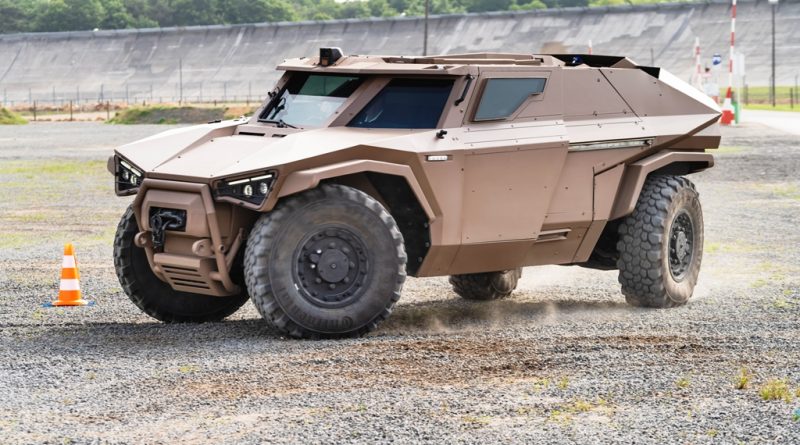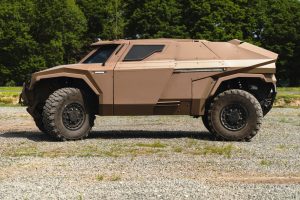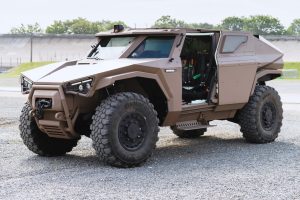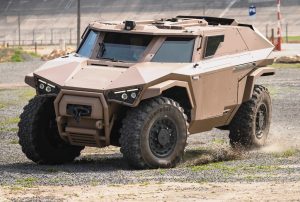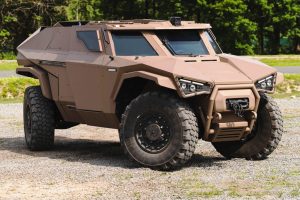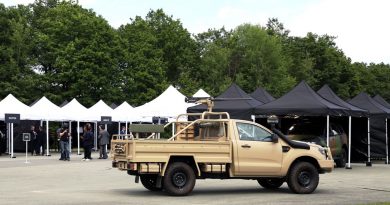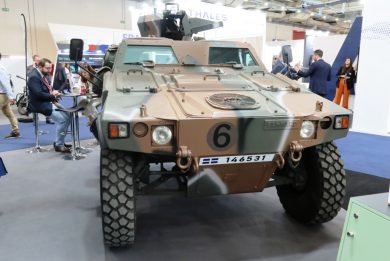The Scarabee crawls forward
Unveiled to selected visitors during Eurosatory 2018, the vehicle was well hidden in the back of the Arquus stand, not much is still known about the Scarabee. However the TechnoDays allowed not only to see it for the first time moving on the ground, but also to discuss with the engineers who developed it and grabbing some more info.
In 2019 the Scarabee entered a second phase of its development, Arquus engineers now aiming at evaluating its performances and behaviour both on paved roads as well as cross country, such as its capacity of overcoming various types of obstacle. The Scarabee was developed using company funding, the work having been carried out in nine months by a dedicated team of six engineers and technicians. Although the programme started from a blank sheet, Arquus engineers looked at the company past programmes such as Panhard armoured cars, VBL and VB2L light vehicles, the Crab concept vehicle, exploiting lessons learned and trying to put together all the relevant features into the Scarabee design, the first drawings having appeared in September 2017 while in June 2018 the prototype vehicle was exhibited at Eurosatory.
The stealth aspect has been the key issue since the beginning, Arquus having analysed customer’s mission cases and developed them in a so-called “agile” method; this started from assumptions, which were then validated leading to prototyping, this iteration circuit having allowed developing the vehicle in such a short time.
As said, the stealth aspect has been one of the design main features, the vehicle being only 1.90 meters high when suspensions are in the low position, ensuring 400 mm ground clearance, which becomes 500 mm in the high position for cross-country operations. The internal layout sees the driver at the front centre, with two seats scaled back right and left, a fourth rear seat on the centreline being reserved to a host, the basic combat crew being of three soldiers. Protection levels have not been unveiled, however a double floor is installed to decouple passengers as much as possible from under-belly blast events, while modular ballistic protection can be added, exploiting part of the available payload.
Personnel access the Scarabee via two sliding doors; these also include a small part of the roof while a step opens before the door slides backwards, all this in order to facilitate access. The step is hinged in the lower point and rotates outwards, while in travel order it closes over the lower part of the door, something that should also have beneficial effects in terms of blast protection. “The geometry of the step comes from that of the TGV, the French high speed train,” an engineer tells EDR On-Line, as he took the idea while waiting for the train in a station. The door architecture allows a soldier to travel standing out of the vehicle while this is moving at low speed. With a GVW of 8 tonnes, the Scarabee has a payload of 2 tonnes, 60% more than the VB2L, the long chassis version of the VBL light armoured vehicle in service with the French Army and other nations. The vehicles maintains some growth potential, as it is fitted with 7-tonnes axels.
The Scarabee was designed since inception for hybrid propulsion, and is based on a chassis fitted with independent suspensions designed by Arquus. The vehicle architecture allows for a quick replacement of the powerpack; all NTI 1 (Niveau Technique d’Intervention n° 1, technical intervention level 1, which in French Army wording means programmed light maintenance) items such as air filters, cooling and hydraulics elements, can be accessed directly from the top to facilitate maintenance.
Arquus does not name the provider of the engine, a 3-liters turbodiesel ensuring a 300 hp output, which is coupled to a 100 hp (or better say 75 kW) electric motor; EDR On-Line understands that in order to save weight the engine comes from the automobile world. A Lithium-Ion powerpack provides power to the electric motor which can be used in four modes: boost, adding its power to that of the diesel engine when maximum thrust is needed, hybrid, full electric when silent and thermal signatures must be minimised, and power generator. Maximum speed on road is in excess of 120 km/h while maximum gradient is of over 60%. Different driving modes are available, economy, for maximum range, mobility, for cross country, and sequential.
The two axles are steerable, the rear one being oriented using a joystick: with a wheelbase of around 4 meters, counter-steering the two axles allows to obtain a turning radius of less than 5 meters, the limited front overhang helping in that, a feature also allowing ingress and egress angles on vertical obstacles of around 70°. However the most appalling view is when both axles are steered the same way, the Scarabee moving diagonally like a crab.
The vehicle can host various types of turrets, ranging from Arquus’ T1, to an antitank turret armed i.e. with MBDA’s MMP missiles, to counter-UAS systems, to sensors of different kind, the model exhibited at Eurosatory having shown the capability of carrying a medium calibre remotely controlled turret.
The vehicle is fitted with the Battlenet Inside vetronic architecture, developed by Arquus.
Currently the Scarabee is used for company trials only, being packed with new technologies, a number of patents having been obtained. Once Arquus will have fully explored the vehicle capabilities and performances, it will start to propose demonstrations and trials to potential customers.
Due to the strict “no-photo” rule, the same applied at Eurosatory, this article will soon be completed with more pictures provided by Arquus.
Photos courtesy Arquus

